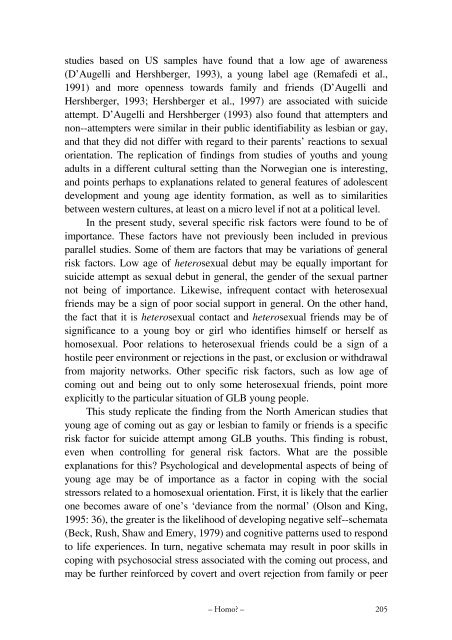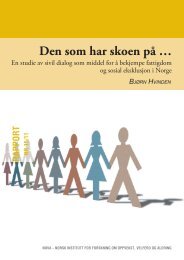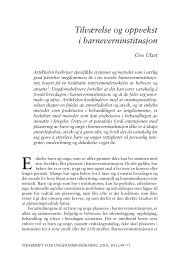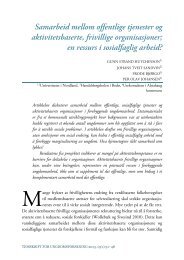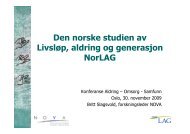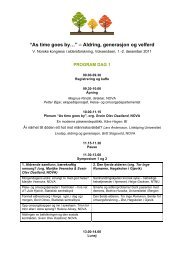Betydningen av seksuell erfaring, tiltrekning og identitet for ...
Betydningen av seksuell erfaring, tiltrekning og identitet for ...
Betydningen av seksuell erfaring, tiltrekning og identitet for ...
You also want an ePaper? Increase the reach of your titles
YUMPU automatically turns print PDFs into web optimized ePapers that Google loves.
studies based on US samples h<strong>av</strong>e found that a low age of awareness<br />
(D’Augelli and Hershberger, 1993), a young label age (Remafedi et al.,<br />
1991) and more openness towards family and friends (D’Augelli and<br />
Hershberger, 1993; Hershberger et al., 1997) are associated with suicide<br />
attempt. D’Augelli and Hershberger (1993) also found that attempters and<br />
non--attempters were similar in their public identifiability as lesbian or gay,<br />
and that they did not differ with regard to their parents’ reactions to sexual<br />
orientation. The replication of findings from studies of youths and young<br />
adults in a different cultural setting than the Norwegian one is interesting,<br />
and points perhaps to explanations related to general features of adolescent<br />
development and young age identity <strong>for</strong>mation, as well as to similarities<br />
between western cultures, at least on a micro level if not at a political level.<br />
In the present study, several specific risk factors were found to be of<br />
importance. These factors h<strong>av</strong>e not previously been included in previous<br />
parallel studies. Some of them are factors that may be variations of general<br />
risk factors. Low age of heterosexual debut may be equally important <strong>for</strong><br />
suicide attempt as sexual debut in general, the gender of the sexual partner<br />
not being of importance. Likewise, infrequent contact with heterosexual<br />
friends may be a sign of poor social support in general. On the other hand,<br />
the fact that it is heterosexual contact and heterosexual friends may be of<br />
significance to a young boy or girl who identifies himself or herself as<br />
homosexual. Poor relations to heterosexual friends could be a sign of a<br />
hostile peer environment or rejections in the past, or exclusion or withdrawal<br />
from majority networks. Other specific risk factors, such as low age of<br />
coming out and being out to only some heterosexual friends, point more<br />
explicitly to the particular situation of GLB young people.<br />
This study replicate the finding from the North American studies that<br />
young age of coming out as gay or lesbian to family or friends is a specific<br />
risk factor <strong>for</strong> suicide attempt among GLB youths. This finding is robust,<br />
even when controlling <strong>for</strong> general risk factors. What are the possible<br />
explanations <strong>for</strong> this? Psychol<strong>og</strong>ical and developmental aspects of being of<br />
young age may be of importance as a factor in coping with the social<br />
stressors related to a homosexual orientation. First, it is likely that the earlier<br />
one becomes aware of one’s ‘deviance from the normal’ (Olson and King,<br />
1995: 36), the greater is the likelihood of developing negative self--schemata<br />
(Beck, Rush, Shaw and Emery, 1979) and c<strong>og</strong>nitive patterns used to respond<br />
to life experiences. In turn, negative schemata may result in poor skills in<br />
coping with psychosocial stress associated with the coming out process, and<br />
may be further rein<strong>for</strong>ced by covert and overt rejection from family or peer<br />
– Homo? – 205


